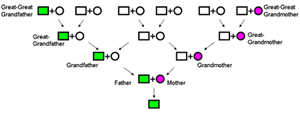Why are these tests so picky?
What these tests look for are small DNA differences between people with different ancestors. These DNA differences exist because our DNA slowly builds up mutations over time. And these changes are specific to certain groups because there wasn't much mixing in the old days. So what changed in Europe, stayed in Europe. Or West Africa. Or Australia. Or…
Where the trouble comes in is with something called recombination. Remember we all have two copies of most of our chromosomes--one from mom and one from dad. Before an egg or sperm is made, the two chromosomes in each pair mix and match pieces with each other. This is recombination.
What this means is that your chromosome 1 from your mom is really a mix of both of her chromosome 1's. The same is true for most of the rest of her chromosomes. And for most of the chromosomes you got from your dad too.
This sort of thing is wonderful for diversity and is one of the big reasons why each generation is different from the last. But it can wreak havoc on DNA ancestry testing. With each generation more and more DNA gets mixed up. What this means is that the genetic trail is lost pretty quickly.
This is why scientists often focus on the two kinds of chromosomes that don't recombine--mitochondrial DNA (mtDNA) and the Y chromosome. The mtDNA is found in a cell's mitochodrion instead of in the nucleus (where all the rest of our DNA is). This cool relic from our evolutionary past comes only from mom. The Y chromosome is the only unpaired chromosome in the nucleus. If a person has a Y chromosome, they are almost always male. Which means this chromosome passes only from dad to sons.
Since neither of these chromosomes have a partner, there isn't any mixing between generations. This means you can really follow them back for long periods of time. In fact, this is how they found ancestral Adam and Eve--by following the trail back to the one person we all have an unbroken paternal or maternal link back to. (Remember, there were people before these folks, they just don't have an unbroken maternal or paternal line.)

This is all very cool but isn't necessarily that helpful if you want to learn about your ancestors. This is because you are really only learning about one ancestor (or a set along a very defined line). For example, in a Y test, you don't see any of the female relatives (or any of their male or female relatives). So the son of a European mom and an African-American dad would only see his dad's roots.
Think about what this means for the Hemmings. If they just did a DNA ancestry test with the Y chromosome, they would conclude that they were of European descent. While this is strictly true along one very specific line, after so many generations most of their other chromosomes are not. So what did they learn about their true ancestry?
 Dr. Barry Starr is a Geneticist-in-Residence at The Tech Museum of Innovation in San Jose, CA.
Dr. Barry Starr is a Geneticist-in-Residence at The Tech Museum of Innovation in San Jose, CA.
latitude 37.3316, longitude -121.89
 A lot of DNA companies are now offering ancestry testing so you can find out more about your ancestors. Overall they can be useful if you have a specific question. But for an overall look at your family's history, they tend to fall short. Let's look at an example to get a feel for what you can and can't find out from most of these tests.
A lot of DNA companies are now offering ancestry testing so you can find out more about your ancestors. Overall they can be useful if you have a specific question. But for an overall look at your family's history, they tend to fall short. Let's look at an example to get a feel for what you can and can't find out from most of these tests.
